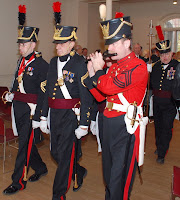 On Monday, November 9, the New York City Chapter of U.S. Daughters of 1812 hosted its service of commemoration and grave-marking to honor Daniel D. Tompkins (1774-1825). The U.S. Daughters’ interest in Tompkins stems from his service as Governor of New York, and Vice President of the United States, and as a crucial financier of the American war effort of 1812. This historical society had held a similar ceremony 70 years earlier, almost to the day, when it dedicated a bronze bust of Tompkins in the yard at St. Mark’s Church-in-the-Bowery, where he is laid to rest.
On Monday, November 9, the New York City Chapter of U.S. Daughters of 1812 hosted its service of commemoration and grave-marking to honor Daniel D. Tompkins (1774-1825). The U.S. Daughters’ interest in Tompkins stems from his service as Governor of New York, and Vice President of the United States, and as a crucial financier of the American war effort of 1812. This historical society had held a similar ceremony 70 years earlier, almost to the day, when it dedicated a bronze bust of Tompkins in the yard at St. Mark’s Church-in-the-Bowery, where he is laid to rest.Freemasonry became involved, if I understand it correctly, almost by accident. Bro. Isaac Moore of Mariners Lodge No. 67 in New York City happened upon Tompkins’ gravesite one day. Struck by the neglected condition of the burial place, he let the brethren know how this illustrious Mason’s final resting place could benefit from some rehabilitation. One of the Masons Isaac had spoken to was Cliff Jacobs, 33° of St. John’s Lodge No. 1 and the Valley of New York City. Ill. Cliff discovered the U.S. Daughters’ project to fix up the gravesite, and the Daughters welcomed the brethren into the endeavor.
The affair on November 9 was a very special and memorable occasion, as I hope these photos will convey.
The final resting place of Daniel D. Tompkins. Governor of New York. Vice President of the United States. Grand Master of New York. Sovereign Grand Commander of the Ancient Accepted Scottish Rite of Freemasonry.
The Veteran Corps of Artillery, State of New York, founded in 1790, served as the color guard for the ceremony.
Freemasonry was represented in numbers that day. That is John Mauk Hilliard at left, accepting a presentation from Anne Farley, Mary Raye Casper, and Emily Malloy of U.S. Daughters of 1812. Also present were Peter Samiec, 33°, Deputy for New York; RW Vincent Libone, Deputy Grand Master of New York; W. Kenneth Lorentzen, Master of Tompkins Lodge No. 471; and several dozen others. Malloy was chairman of U.S. Daughters’ Tompkins Commemoration Committee.
Left: Brian G. Andersson, Commissioner of the New York City Department of Records and Information Services, presented a proclamation from Mayor Michael Bloomberg. Right: Dr. George Hill is a descendant of Daniel D. Tompkins.
The Rev. Michael Relyea of St. Mark’s Church-in-the-Bowery reflected on the life of Daniel Tompkins, crediting him with outspoken support of Abolition, scores of years ahead of the Civil War, which Relyea attributed to the reversals of fortune Tompkins suffered at the end of his life.
Ill. John William McNaughton, 33°, Sovereign Grand Commander of the AASR-NMJ, saluted his predecessor’s service to the American people and to Freemasonry.
St. Mark’s Church-in-the-Bowery is located in the Lower East Side of Manhattan. Its yards contain the burial places of a number of early Dutch settlers of New York, most notably Petrus ‘Peter’ Stuyvesant, Captain General and Governor in Chief of Amsterdam in New Netherland (New York) and the Dutch West India Islands (1612-72).




















































































